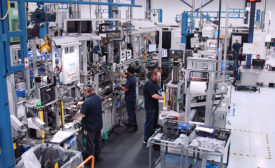Home » continuous improvement
Articles Tagged with ''continuous improvement''
How Lean Helped GE’s Turbine Factory Find Its Mojo
Lean has enabled GE’s turbine assembly plant in Greenville, SC, to save money, improve quality, and reduce manufacturing time
December 3, 2020
Eliminating the Seven Deadly Wastes
Manufacturers should evaluate processes to reduce hidden causes of waste
December 4, 2019
Lean Culture Drives Continuous Improvement
Leadership engagement is key to changing employee behavior.
December 10, 2018
Operational Excellence Starts With Culture
To achieve operational excellence, the existing corporate culture must be addressed head on.
January 6, 2017
2016 Assembly Plant of the Year: Bosch Rexroth Flexes Its Lean Production Muscle
High-mix lines and continuous improvement drive growth in Fountain Inn, SC.
October 1, 2016
Never miss the latest news and trends driving the manufacturing industry
Stay in the know on the latest assembly trends.
JOIN TODAY!Copyright ©2024. All Rights Reserved BNP Media.
Design, CMS, Hosting & Web Development :: ePublishing












